NCERT Exemplar Solutions: Lines & Angles | Mathematics (Maths) Class 7 (Old NCERT) PDF Download
Exercise Page: 128
In questions 1 to 41, there are four options out of which one is correct. Write the correct one.
Q.1. The angles between North and West and South and East are
(a) complementary
(b) supplementary
(c) both are acute
(d) both are obtuse
Ans: (b)
Explanation: The angle between North and West is 90o, angle between South and East is 90o as shown in the figure above. So, 90o + 90o = 180o.
The angle between North and West is 90o, angle between South and East is 90o as shown in the figure above. So, 90o + 90o = 180o.
Then, the angles between North and West and South and East are supplementary.
When the sum of the measures of two angles is 180°, then the angles are called supplementary angles.
Q.2. Angles between South and West and South and East are
(a) vertically opposite angles
(b) complementary angles
(c) making a linear pair
(d) adjacent but not supplementary
Ans: (c)
Explanation: making a linear pair A linear pair is a pair of adjacent angles whose non-common sides are opposite rays.
Q.3. In Fig. 5.9, PQ is a mirror, AB is the incident ray and BC is the reflected ray. If ∠ ABC = 46o, then ∠ ABP is equal to (a) 44o
(a) 44o
(b) 67o
(c) 13o
(d) 62o
Ans: (b)
Explanation: As we know that, the angle formed by the incident ray and angle formed by the reflected ray is equal.
From the given figure,
PQ is a straight line,
So, ∠ABP + ∠ABC + ∠CBQ = 180o
Let us assume the ∠ABP = ∠CBQ = x
Then,
x + 46o + x = 180o
2x + 46o = 180o
2x = 180o – 46o
2x = 134o
x = 134o/2
x = 67o
Therefore, the ∠ABP = ∠CBQ = 67o
Q.4. If the complement of an angle is 79o, then the angle will be of
(a) 1o
(b) 11o
(c) 79o
(d) 101o
Ans: (b)
Explanation: When the sum of the measures of two angles is 90°, the angles are called complementary angles. Each of them is called complement of the other.
The given complement of an angle is 79o
Let the measure of the angle be xo.
Then,
x + 79o = 90o
x = 90o – 79o
x = 11o
Hence, the measure of the angle is 11o.
Q.5. Angles which are both supplementary and vertically opposite are
(a) 95o, 85o
(b) 90o, 90o
(c) 100o, 80o
(d) 45o, 45o
Ans: (b)
Explanation: When the sum of the measures of two angles is 180°, then the angles are called supplementary angles.
Q.6. The angle which makes a linear pair with an angle of 61o is of
(a) 29o
(b) 61o
(c) 122o
(d) 119o
Ans: (d)
Explanation: A linear pair is a pair of adjacent angles whose non-common sides are opposite rays.
We know that, measure of sum of adjacent angles is equal to 180o.
Let the measure of other angle be xo.
Then,
x + 61o = 180o
x = 180o – 61o
x = 119o
Q.7. The angles x and 90o – x are
(a) supplementary
(b) complementary
(c) vertically opposite
(d) making a linear pair
Ans: (b)
Explanation: When the sum of the measures of two angles is 90o, then the angles are called complementary angles.
x + 90o – x = 90o
90o = 90o
LHS = RHS
Q.8. The angles x – 10o and 190o – x are
(a) interior angles on the same side of the transversal
(b) making a linear pair
(c) complementary
(d) supplementary
Ans: (d)
Explanation: When the sum of the measures of two angles is 180o, then the angles are called supplementary angles.
x – 10o + 190o – x = 180o
190o – 10 = 180o
180o = 180o
LHS = RHS
Q.9. In Fig. 5.10, the value of x is
(a) 110o
(b) 46o
(c) 64o
(d) 150o
Ans: (d)
Explanation: Sum of all angles about a point given in the figure are equal to 360o.
Then, 100o + 46o + 64o + x = 360o
210o + x = 360o
x = 360o – 210o
x = 150o
Q.10. In Fig. 5.11, if AB || CD, ∠ APQ = 50o and ∠PRD = 130o, then ∠ QPR is (a) 130o
(a) 130o
(b) 50o
(c) 80o
(d) 30o
Ans: (c)
Explanation:
We know that, ∠APR = ∠PRD … [because interior alternate angles]
∠APQ + ∠QPR = 130o
50o + ∠QPR = 130o
∠QPR = 130o – 50o
∠QPR = 80o
Q.11. In Fig. 5.12, lines l and m intersect each other at a point. Which of the following is false?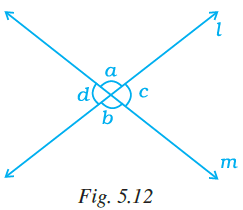
(a) ∠a = ∠b
(b) ∠d = ∠c
(c) ∠a + ∠d = 180o
(d) ∠a = ∠d
Ans: (d)
Explanation:
∠a ≠ ∠d
∠a = ∠b [because vertically opposite angles]
∠d = ∠c [because vertically opposite angles]
∠a + ∠d = 180o [Linear pair of angles]
Q.12. If angle P and angle Q are supplementary and the measure of angle P is 60o, then the measure of angle Q is
(a) 120o
(b) 60o
(c) 30o
(d) 20o
Ans: (a)
Explanation: When the sum of the measures of two angles is 180o, then the angles are called supplementary angles.
P + Q = 180o
60o + Q = 180o
Q = 180o – 60o
Q = 120o
Q.13. In Fig. 5.13, POR is a line. The value of a is
(a) 40o
(b) 45o
(c) 55o
(d) 60o
Ans: (a)
Explanation:
We know that, when the sum of the measures of two angles is 180o, then the angles are called supplementary angles.
(3a + 5)o + (2a – 25)o = 180o
3a + 5 + 2a – 25 = 180o
5a – 20 = 180o
5a = 180o + 20
5a = 200
a = 200/5
a = 40o
Q.14. In Fig. 5.14, POQ is a line. If x = 30°, then ∠ QOR is (a) 90o
(a) 90o
(b) 30o
(c) 150o
(d) 60o
Ans: (a)
Explanation: Sum of all angles about a straight line given in the figure are equal to 180o.
Then, 30o + 2y + 3y = 180o
30o + 5y = 180o
5y = 180o – 30o
5y = 150o
y = 150/5
y = 30o
So, 2y = 2 × 30 = 60o
3y = 3 × 30 = 90o
Therefore, ∠ QOR = 90o
Q.15. The measure of an angle which is four times its supplement is
(a) 36o
(b) 144o
(c) 16o
(d) 64o
Ans: (b)
Explanation: We know that, when the sum of the measures of two angles is 180o, then the angles are called supplementary angles.
Let us assume the angle be x.
Then, its supplement angle = (180o – x)
As per the condition given in the question, x = 4 (180o – x)
x = 720o – 4x
x + 4x = 720o
5x = 720o
x = 720o/5
x =144o
Q.16. In Fig. 5.15, the value of y is
(a) 30o
(b) 15o
(c) 20o
(d) 22.5o
Ans: (c)
Explanation: Sum of all angles about a straight line given in the figure are equal to 180o.
Then, 6y + y + 2y = 180o
9y = 180o
y = 180/9
y = 20o
So, value of y is 20o.
Q.17. In Fig. 5.16, PA || BC || DT and AB || DC. Then, the values of a and b are respectively.
(a) 60o, 120o
(b) 50o, 130o
(c) 70o, 110o
(d) 80o, 100o
Ans: (b)
Explanation: We know that, ∠PAB = ∠ABC = 50o … [because interior alternate angles]
Given, AB || DC so consider it as parallelogram,
In parallelogram adjacent angles of a parallelogram are supplementary.
So, ∠ABC + ∠BCD = 180o
50o + ∠BCD = 180o
∠BCD = 180o – 50o
∠BCD = 130o
∠BCD = ∠CDT = 130o … [because interior alternate angles]
Therefore, a = 50o and b = 130o
Q.18. The difference of two complementary angles is 30o. Then, the angles are
(a) 60o, 30o
(b) 70o, 40o
(c) 20o, 50o
(d) 105o, 75o
Ans: (a)
Explanation: When the sum of the measures of two angles is 90o, then the angles are called complementary angles.
So, 60o + 30o = 90o
As per the condition in the question, 60o – 30o = 30o
Q.19. In Fig. 5.17, PQ || SR and SP || RQ. Then, angles a and b are respectively
(a) 20o, 50o
(b) 50o, 20o
(c) 30o, 50o
(d) 45o, 35o
Ans: (a)
Explanation:
∠QRP = ∠RPS = 50o … [because interior alternate angles]
∠SRP = ∠RPQ = 20o … [because interior alternate angles]
Therefore, angle a = 20o and angle b = 50o
Q.20. In Fig. 5.18, a and b are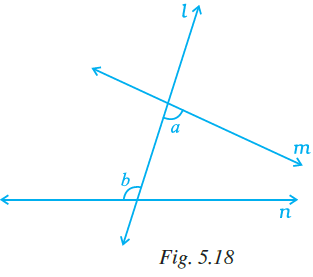
(a) alternate exterior angles
(b) corresponding angles
(c) alternate interior angles
(d) vertically opposite angles
Ans: (c)
Q.21. If two supplementary angles are in the ratio 1: 2, then the bigger angle is
(a) 120o
(b) 125o
(c) 110o
(d) 90o
Ans: (a)
Explanation: We know that, when the sum of the measures of two angles is 180o, then the angles are called supplementary angles.
Let us assume two angles be 1x and 2x.
1x + 2x = 180o
3x = 180o
x = 180o/3
x = 60o
Then the bigger angle is 2x = 2 × 60o = 120o
Q.22. In Fig. 5.19, ∠ROS is a right angle and ∠POR and ∠QOS are in the ratio 1: 5. Then, ∠QOS measures
(a) 150o
(b) 75o
(c) 45o
(d) 60o
Ans: (b)
Explanation: Sum of all angles about a straight line given in the figure are equal to 180o.
Given, ∠ROS is a right angle = 90o
Let us assume ∠POR = x and ∠QOS = 5x.
Then, ∠POR + ∠ROS + ∠QOS = 180o
x + 90o + 5x = 180o
6x = 180o – 90o
6x = 90o
x = 90o/6
x = 15o
So, ∠QOS measures = 5x = 5 × 15o = 75o
Q.23. Statements a and b are as given below:
a : If two lines intersect, then the vertically opposite angles are equal.
b : If a transversal intersects, two other lines, then the sum of two interior angles on the same side of the transversal is 180o.
Then
(a) Both a and b are true
(b) a is true and b is false
(c) a is false and b is true
(d) both a and b are false
Ans: (b)
Q.24. For Fig. 5.20, statements p and q are given below:
p : a and b are forming a linear pair.
q : a and b are forming a pair of adjacent angles.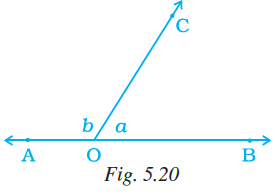
Then,
(a) both p and q are true
(b) p is true and q is false
(c) p is false and q is true
(d) both p and q are false
Ans: (a)
Q.25. In Fig. 5.21, ∠AOC and ∠ BOC form a pair of (a) vertically opposite angles
(a) vertically opposite angles
(b) complementary angles
(c) alternate interior angles
(d) supplementary angles
Ans: (d)
Q.26. In Fig. 5.22, the value of a is
(a) 20o
(b) 15o
(c) 5o
(d) 10o
Ans: (d)
Explanation: 
∠AOF = ∠COD = 90o [because vertically opposite angles]
Sum of all angles about a straight line given in the figure are equal to 180o.
Then, ∠BOC + ∠COD + ∠DOE = 180o
40o + 90o + 5a = 180o
130o + 5a = 180o
5a = 180o – 130o
5a = 50o
a = 50/5
a = 10o
Q.27. In Fig. 5.23, if QP || SR, the value of a is
(a) 40o
(b) 30o
(c) 90o
(d) 80o
Ans: (c)
Explanation:
To find out the value of ‘a’, draw a line XY, to cut at ‘a’.
So, XY || SR
∠XTS = ∠TSR = 30o … [because interior alternate angles]
∠PQT = ∠QTX = 60o … [because interior alternate angles]
Then, a = ∠XTS + ∠QTX
= 30o + 60o
= 90o
Q.28. In which of the following figures, a and b are forming a pair of adjacent angles?
Ans: In figure (d) a and b are forming a pair of adjacent angles.
Q.29. In a pair of adjacent angles,
(i) vertex is always common
(ii) one arm is always common
(iii) uncommon arms are always opposite rays
Then
(a) All (i), (ii) and (iii) are true
(b) (iii) is false
(c) (i) is false but (ii) and (iii) are true
(d) (ii) is false
Ans: (b)
Explanation:
(i) Vertex is always common: This is true. Adjacent angles share the same vertex.
(ii) One arm is always common: This is also true. Adjacent angles share one common arm (side).
(iii) Uncommon arms are always opposite rays: This is false. For angles to be adjacent, the uncommon arms lie on opposite sides of the common arm, but they don't necessarily have to form a straight line (opposite rays). If they do form a straight line, the adjacent angles are also a linear pair.
Therefore, (i) and (ii) are true, but (iii) is false.
So, the correct answer is (b) (iii) is false.
Q.30. In Fig. 5.25, lines PQ and ST intersect at O. If ∠POR = 90° and x : y = 3 : 2, then z is equal to (a) 126°
(a) 126°
(b) 144°
(c) 136°
(d) 154°
Ans: (b)
Explanation: Sum of all angles about a straight line given in the figure are equal to 180o.
PQ is a straight line.
Then, ∠POR + ∠ROT + ∠TOQ = 180o
Given, x : y = 3 : 2
Let us assume x = 3a, y = 2a
90o + 3a + 2a = 180o
90o + 5a = 180o
5a = 180o – 90o
5a = 90o
a = 90/5
a = 18o
So, x = 3a = 3 × 18 = 54o
y = 2a = 2 × 18 = 36o
From the figure SOT is a straight line,
Then, z+ y = 180o
z + 36o = 180o
z = 180o – 36o
z = 144o
Q.31. In Fig. 5.26, POQ is a line, then a is equal to 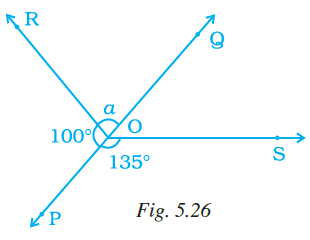
(a) 35o
(b) 100o
(c) 80o
(d) 135o
Ans: (c)
Explanation:
From the figure POQ is a straight line,
Then, 100 + a = 180o
a = 180o – 100
a= 80o
Q.32. Vertically opposite angles are always
(a) supplementary
(b) complementary
(c) adjacent
(d) equal
Ans: (d)
Q.33. In Fig. 5.27, a = 40o. The value of b is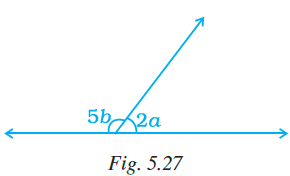 (a) 20o
(a) 20o
(b) 24o
(c) 36o
(d) 120o
Ans: (a)
Explanation: Given, a = 40o
Then, 2a = 2 × 40 = 80o
From the figure, angles formed on the straight line are equal to 180o,
Then, 5b + 2a = 180o
5b + 80o = 180o
5b= 180o – 80o
5b = 100o
b = 100/5
b = 20o
Q.34. If an angle is 60o less than two times of its supplement, then the greater angle is
(a) 100o
(b) 80o
(c) 60o
(d) 120o
Ans: (a)
Explanation: Let us assume the angle be P.
Then, its supplement is 180o – P
As per the condition in the question,
P = 2(180o – P) – 60o
P = 360o – 2P – 60o
P + 2P = 300o
3P = 300o
P = 300/3
P = 100o
So, its supplement is 180o – P = 180o – 100o = 80o
Therefore, the greater angle is 100o.
Q.35. In Fig. 5.28, PQ || RS. If ∠1 = (2a + b)o and ∠6=(3a – b)o, then the measure of ∠2 in terms of b is (a) (2 + b)o
(a) (2 + b)o
(b) (3 – b)o
(c) (108 – b)o
(d) (180 – b)o
Ans: (c)
Explanation:
From the question it is given that, ∠1 = (2a + b)o and ∠6 = (3a – b)o
Since ∠5 and ∠6 forms a linear pair of angles
Then,
∠5 = (180-3a + b)o … [equation 1]
∠5 = ∠1 = (180-3a + b)o [Because Corresponding angles] …equation (2)
From equation (2) we get,
2a + b = 180-3a + b
5a = 180
a = 360
Since ∠1 and ∠2 forms a linear pair so
∠2 = 1800– 2a-b
Substituting the value of a
∠2 = 1800– 720 – b
∠2 = 1080– b
Q.36. In Fig. 5.29, PQ||RS and a : b = 3 : 2. Then, f is equal to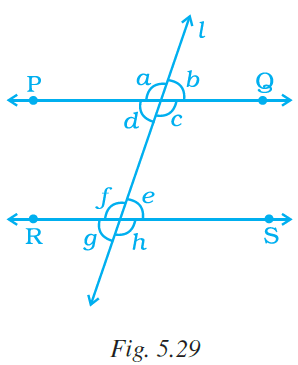
(a) 36o
(b) 108o
(c) 72o
(d) 144o
Ans: (b)
Explanation:
From the figure, PQ||RS.
From the question it is given that, a: b = 3: 2
So, let us assume a = 3m and b = 2m
We know that, sum of angles on the straight line is equal to 180o
Then, ∠a + ∠b = 180o
3m + 2m = 180o
5m = 180o
m = 180o/5
m = 36o
So, a = 3m = 3 × 36o = 108o
b = 2m = 2 × 36o = 72
Therefore, ∠a = ∠f = 108o [because corresponding angles]
Q.37. In Fig. 5.30, line l intersects two parallel lines PQ and RS. Then, which one of the following is not true? (a) ∠1 = ∠3
(a) ∠1 = ∠3
(b) ∠2 = ∠4
(c) ∠6 = ∠7
(d) ∠4 = ∠8
Ans: (d)
Q.38. In Fig. 5.30, which one of the following is not true? (a) ∠1 + ∠5 = 180o
(a) ∠1 + ∠5 = 180o
(b) ∠2 + ∠5 = 180o
(c) ∠3 + ∠8 = 180o
(d) ∠2 + ∠3 = 180o
Ans: (d)
Explanation: We know that, interior opposite angles are equal
∠2 = ∠3
Q.39. In Fig. 5.30, which of the following is true? (a) ∠1 = ∠5
(a) ∠1 = ∠5
(b) ∠4 = ∠8
(c) ∠5 = ∠8
(d) ∠3 = ∠7
Ans: (c)
Explanation: From the figure, PQ||RS
∠5 = ∠8 [interior alternate angles are equal]
Q.40. In Fig. 5.31, PQ||ST. Then, the value of x + y is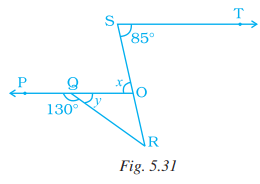 (a) 125o
(a) 125o
(b) 135o
(c) 145o
(d) 120o
Ans: (b)
Explanation: From the figure, PO is a straight line
We know that, sum of angles on the straight is equal to 180o.
Then,
y + ∠ PQR = 1800
y + 1300 = 1800
y = 50o
Then,
∠ QOS = ∠ TSO [Co-interior angle]
x = 850
x + y = 135
Q.41. In Fig. 5.32, if PQ||RS and QR||TS, then the value a is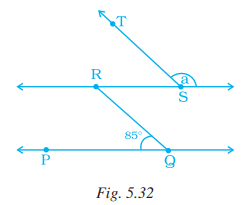 (a) 95o
(a) 95o
(b) 90o
(c) 85o
(d) 75o
Ans: (a)
Explanation: We know that, corresponding angles are equal
So,
∠ RQP = ∠ TSR = 850 (Corresponding angles)
a + ∠ TSR = 1800
∠a = 95
In questions 42 to 56, fill in the blanks to make the statements true.
Q.42. If sum of measures of two angles is 90o, then the angles are _________.
Solution: If sum of measures of two angles is 90o, then the angles are complementary.
Q.43. If the sum of measures of two angles is 180o, then they are _________.
Solution: If the sum of measures of two angles is 180o, then they are supplementary.
Q.44. A transversal intersects two or more than two lines at _________ points.
Solution: A transversal intersects two or more than two lines at distinct points.
If a transversal intersects two parallel lines, then (Q. 45 to 48).
Q.45. sum of interior angles on the same side of a transversal is.
Solution: Sum of interior angles on the same side of a transversal is 180o.
Q.46. Alternate interior angles have one common .
Solution: Alternate interior angles have one common arm.
Q.47. Corresponding angles are on the side of the transversal.
Solution: Corresponding angles are on the same side of the transversal.
Q.48. Alternate interior angles are on the side of the transversal.
Solution: Alternate interior angles are on the opposite side of the transversal
Q.49. Two lines in a plane which do not meet at a point anywhere are called lines.
Solution: Two lines in a plane which do not meet at a point anywhere are called parallel lines.
Q.50. Two angles forming a __________ pair are supplementary.
Solution: Two angles forming a linear pair are supplementary.
Q.51. The supplement of an acute is always __________ angle.
Solution: The supplement of an acute is always obtuse angle.
Q.52. The supplement of a right angle is always _________ angle.
Solution: The supplement of a right angle is always right angle.
Q.53. The supplement of an obtuse angle is always _________ angle.
Solution: The supplement of an obtuse angle is always acute angle.
Q.54. In a pair of complementary angles, each angle cannot be more than _________.
Solution: In a pair of complementary angles, each angle cannot be more than 90o.
Q.55. An angle is 45o. Its complementary angle will be __________ .
Solution: An angle is 45o. Its complementary angle will be 45o.
Q.56. An angle which is half of its supplement is of __________.
Solution: An angle which is half of its supplement is of 60o.
Let us assume the angle be p, and supplement be 2p
p + 2p = 1800
3p = 1800
p = 600
Q.57. Two right angles are complementary to each other.
Solution: False
As two right angles are supplementary to each other.
Q.58. One obtuse angle and one acute angle can make a pair of complementary angles.
Solution: False
As two acute angles can make a pair of complementary angles.
Q.59. Two supplementary angles are always obtuse angles.
Solution: False
Q.60. As one acute angle and one obtuse angle can make two supplementary angles. Two right angles are always supplementary to each other.
Solution: True
Since, 90° + 90° = 180°, a supplementary angle.
Q.61. One obtuse angle and one acute angle can make a pair of supplementary angles.
Solution: True
Q.62. Both angles of a pair of supplementary angles can never be acute angles.
Solution: True
Q.63. Two supplementary angles always form a linear pair.
Solution: True
Q.64. Two angles making a linear pair are always supplementary.
Solution: True
Q.65. Two angles making a linear pair are always adjacent angles.
Solution: True
Q.66. Vertically opposite angles form a linear pair.
Solution: False
As vertically opposite angles are always equal but do not form a linear pair.
Q.67. Interior angles on the same side of a transversal with two distinct parallel lines are complementary angles.
Solution: False
As interior angles on the same side of a transversal with two distinct parallel lines are supplementary angles.
Q.68. Vertically opposite angles are either both acute angles or both obtuse angles.
Solution: True
Q.69. A linear pair may have two acute angles.
Solution: False
As a linear pair has one acute angle and one obtuse angle
Q.70. An angle is more than 45°. Its complementary angle must be less than 45°.
Solution: True
Let A and B are two angles making a complementary angle pair and A is greater than 45°
A + B = 90°
⇒ B = 90° – A
Therefore, B will be less than 45°.
Q.71. Two adjacent angles always form a linear pair.
Solution: False
As if both adjacent angles are acute angles, then they do not form a linear pair.
Q.72. Write down each pair of adjacent angles shown in the following figures:
(i)
(ii)
(iii)
(iv) 
Solution:
(i) ∠AOB and ∠BOC; ∠AOC and ∠COD; ∠AOB and ∠BOD; and ∠BOC and ∠COD are adjacent angles.
(ii) ∠PQT and ∠PQR; ∠ORU and ∠QRP; ∠RPS and ∠RPQ are adjacent angles.
(iii) ∠TSV and ∠USV; ∠SVT and ∠SVU are adjacent angles.
(iv) ∠AOC and ∠AOD; ∠BOC and ∠BOD; ∠AOC and ∠BOC, ∠AOD and ∠BOD are adjacent angles.
Q.73. In each of the following figures, write, if any,
(i) each pair of vertically opposite angles, and
(ii) each linear pair.
(i)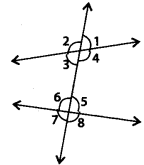
(ii)
(iii)
(iv)
Solution:
(i) ∠1 and ∠3; ∠2 and ∠4; ∠5 and ∠7; ∠6 and ∠8 are four pairs of vertically opposite angles.
∠1 and ∠2; ∠1 and ∠4; ∠2 and ∠3; ∠3 and ∠4; ∠5 and ∠6; ∠5 and ∠8; ∠6 and ∠7; ∠7 and ∠8 are linear pairs.
(ii) There is no pair of vertically opposite angles.
∠ABD and ∠DBC; ∠ABE and ∠CBE are linear pairs.
(iii) There is no pair of vertically opposite angles and no angles are in the form of linear pair.
(iv) ∠POR and ∠QOS; ∠ROQ and ∠POS are two pairs of vertically opposite angles.
∠POR and ∠ROQ; ∠ROQ and ∠OOS; ∠QOS and ∠SOP; ∠SOP and ∠POR; ∠ROT and ∠TOS; ∠OOT and ∠POT are linear pairs.
Q.74. Name the pairs of supplementary angles in the following figures:
(i) 
(ii) 
(iii) 
Solution: (i) ∠AOD and ∠DOB; ∠DOB and ∠BOC, ∠BOC and ∠AOC; ∠AOC and ∠AOD are four pairs of supplementary angles.
(ii) ∠POS and ∠SOQ; ∠POR and ∠ROQ are two pairs of supplementary angles.
(iii) ∠1 and ∠2, ∠3 and ∠4, ∠5 and ∠6 are three pairs of supplementary angles.
Q.75. In the given figure, PO || RS, TR || QU and ∠PTR = 42°. Find ∠QUR.
Solution: Since, PQ || RS and TR is a transversal.
∴ ∠PTR – ∠TRU= 42° ——— (i) [Alternate interior angles]
Also, TR || QU and RS is a transversal.
∴ ∠TRU + ∠QUR = 180° [Co-interior angles]
⇒ 42° + ∠QUR = 180° [Using (i)]
⇒ ∠QUR = 180° – 42° = 138°
Q.76. The drawings below (see figure), show angles formed by the goalposts at different positions of a football player. The greater the angle, the better chance the player has of scoring a goal. For example, the player has a better chance of scoring a goal from Position A than from Position B.
(i)
(ii)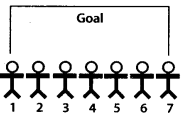
(iii)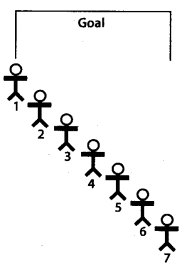
In Parts (a) and (b) given below, it may help to trace the diagrams and draw and measure angles.
(a) Seven football players are practicing their kicks. They are lined up in a straight line in front of the goalpost [See fig.(i)). Which player has
the best the greatest) kicking angle?
(b) Now the players are lined up as shown in Fig. (ii). Which player has the best kicking angle?
(c) Estimate atleast two situations such that the angles formed by different positions of two players are complement to each other.
Solution:
(a) 4th player has the greatest kicking angle. So, this player has the best kicking angle.
(b) 4th player has the greatest kicking angle. So, this player has the best kicking angle.
(c) (45°, 45°) and (60°, 30°) are the two pairs of angles formed by different positions of two players such that they are complement to each other.
(∵ 45° + 45° = 90° and 60° + 30°= 90°).
Q.77. The sum of two vertically opposite angles is 166°. Find each of the angles.
Solution:
Since, vertically opposite angles are equal.
Let each angle be x.
According to question,
x + x = 166°
⇒ 2x = 166°
Thus, both the angles are of 83°.
Q.78. In the given figure, l || m || n. ∠OPS = 35° and ∠QRT = 55°. Find ∠PQR.
Solution:
We have,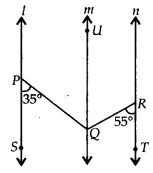
l || m and PQ is a transversal
∴ ∠SPQ = ∠PQU [Alternate interior angles]
⇒ ∠PQU = 35° ———- (i)
Also, m || n and QR is a transversal.
∴ ∠QRT = ∠RQU [Alternate interior angles]
⇒ ∠RQU = 35° ——- (ii)
Now, ∠PQR = ∠PQU + ∠UQR
= 35° + 55° [Using (6) & (ii)]
= 90°
Q.79. In the given figure, P, Q and R are collinear points and TQ ⊥ PR,
Name;
(a) pair of complementary angles
(b) two pairs of supplementary angles.
(c) four pairs of adjacent angles.
Solution: (a) ∠TOS and ∠SQR is a pair of complementary angles.
(b) ∠PQT and ∠TOR; ∠SQR and ∠PQS are two pairs of supplementary angles.
(c) ∠PQT and ∠TQS; ∠TQS and SQR; ∠PQT and ∠TOR; ∠PQS and ∠SQR are four pairs of adjacent angles.
Q.80. In the given figure, OR ⊥ OP.
(i) Name all the pairs of adjacent angles.
(ii) Name all the pairs of complementary angles.
Solution: (i) ∠x and ∠y; ∠x and ∠y + ∠z; ∠y and ∠z; ∠z and ∠x + ∠y are four pairs of adjacent angles.
(ii) ∠x and ∠y are complementary angles. If ∠x = ∠y = ∠z, then ∠x and ∠y; ∠y and ∠z; ∠z and ∠x are three pairs of complementary angles.
Q.81. If two angles have a common vertex and their arms form opposite rays (see figure). Then,
(a) how many angles are formed?
(b) how many types of angles are formed?
(c) write all the pairs of vertically opposite angles.
Solution: (a) 13 angles are formed.
(b) 4 types of angles are formed i.e., vertically opposite angles, adjacent angles, supplementary angles and linear pairs.
(c) ∠1 and ∠3; ∠2 and ∠4 are the two pairs of vertically opposite angles.
Q.82. In (given figures) are the following pairs of angles adjacent? Justify your answer.
(i)
(ii)
(iii)
(iv)
Solution: (i) Yes, and b are the adjacent angles as they have a common vertex, one common arm and other non-common arms on the opposite side of the common arm.
(ii) No, a and b are not adjacent angles as they don’t have common arm.
(iii) No, a and b are not adjacent angles as they don’t have common vertex.
(iv) No, a and b are not adjacent angles as the arms which are not common are on the same side of common arm.
Q.83. In the given figure, write all the pairs of supplementary angles.
Solution: ∠1 and ∠8; ∠2 and ∠7; ∠3 and ∠4; ∠4 and ∠5; ∠5 and ∠6; ∠3 and ∠6 are six pairs of supplementary angles.
Q.84. What is the type of other angle of a linear pair if
(a) one of its angles is acute?
(b) one of its angles is obtuse?
(c) one of its angles is right?
Solution: (a) If one of the angles is acute, then other angle of a linear pair is obtuse.
(b) If one of the angles is obtuse, then other angle of a linear pair is acute.
(c) If one of the angles is right, then other angle of a linear pair is also right.
Q.85. Can two acute angles form a pair of supplementary angles? Give reason in support of your answer.
Solution: No, two acute angles cannot form a pair of supplementary angles. As if both angles are 89° and 89°, even then they cannot make the sum 180°.
Q.86. Two lines AB and CD intersect at O (see figure). Write all the pairs of adjacent angles by taking angles 1, 2, 3, and 4 only.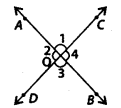
Solution: ∠1 and ∠2; ∠1 and ∠4; ∠2 and ∠3; ∠3 and ∠4 are four pairs of adjacent angles.
Q.87. If the complement of an angle is 62°, then find its supplement.
Solution: Let the angle be x.
∴ Its complement = 90° – x
According to question,
90° – x = 62°
⇒ 90° – 62° = x
⇒ x = 28°
∴ Supplement of x = 180° – 28° = 152°
Q.88. A road crosses a railway line at an angle of 30° as shown in figure. Find the values of a, b and c.
Solution: We have,
Since, l || m and q is a transversal
∴ ∠1 = 30° ——– (i) [Corresponding angles]
Also, m is a straight line.
∴ ∠b + ∠1 = 180° [Linear pair]
⇒ ∠b = 180° – 30° = 150° [Using (1)]
Now, p || q and m is a transversal.
∴ ∠1 = ∠3 = 30° ——— (ii) [Corresponding angles]
∠a = ∠3 [Vertically opposite angles]
∴ ∠a = 30° [Using (ii)]
Also, p || q and l is a transversal.
∴ ∠2 = 30° [Corresponding angles]
Now, l is a straight line.
∴ ∠c + ∠2 = 180° [Linear pair]
⇒ ∠c + 30° = 180° [Using (iii)]
⇒ ∠c = 180° – 30° = 150°
Hence, ∠a = 30°, ∠b = 150°, ∠c = 150°
Q.89. The legs of a stool make an angle of 35″ with the floor as shown in figure. Find the angles x and y.
Solution: We have,
l || m and QR is a transversal.
∴ ∠x = 35° [Alternate interior angles]
and ∠y + 35° = 180° [Co-interior angles]
⇒ ∠y = 180° – 35° = 145°
Hence, ∠x = 35° and ∠y = 145°.
Q.90. Iron rods a, b, c, d,e and fare making a design in a bridge as shown in figure, in which a || b. c || d, e || f. Find the marked angles between
(i) b and c
(ii) d and e
(iii) d and f
(iv) c and f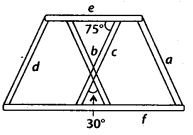
Solution: (i) Let the angle between b and c is ∠1. and ∠1 = 30°[Vertically opposite angles]

(ii) Let the angle between d and e is ∠2.
Now, c || d and e is a transversal.
∴ ∠2 + 75° = 180° [Co-interior angles]
⇒ ∠2 = 180° – 75° = 105°
(iii) Let the angle between d and fis ∠3.
Now, e || f and d is a transversal.
∴ ∠2 + 3 = 180° [Co-interior angles]
⇒ ∠3 – 180° – 105° = 75° [From (ii) part]
(iv) Let the angle between c and fig ∠4.
Now, e || f and c is a transversal.
∴ ∠4 = 75° [Alternate interior angles]
Q.91. Amisha makes a star with the help of line segments a, b, d, e and f, in which a || d, b || e and c || f. Chhaya marks an angle as 120° as shown in figure, and asks Amisha to find the ∠x, ∠y and ∠z. Help Amisha in finding the angles.
Solution: We have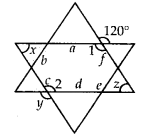
∠1 = 120° ———- (i) [Vertically opposite angles]
c || f and a is transversal.
∴ ∠1 + ∠x = 180° [Co-interior angles]
⇒ 120° + ∠x – 180° [Using (1)]
⇒ ∠x = 180° – 120° = 60°
Now, a || d and c is a transversal.
⇒ ∠x + ∠2 = 180° [Co-interior angles]
⇒ 60° + ∠2 = 180° [Using (ii)]
⇒ ∠2 = 180° -60° = 120°
⇒ ∠2 = ∠y = 120° [Vertically opposite angles]
Also, a || d and f is a transversal.
∴ ∠1 + ∠z = 180° (Co-interior angles)
⇒ 120° + ∠z= 180° [Using (i)]
⇒ ∠z = 180° – 120° = 60°
Thus, ∠x = 60°, ∠y = 120°and ∠z = 60°
Q.92. In the given figure, AB || CD, AF || ED, ∠AFC = 68°and ∠FED = 42°. Find ∠EFD.
Solution: We have,
Since, AF || ED and FD is a transversal.
∴ ∠3=68° ——– (i) [Corresponding angles]
Now, AB || CD and ED is a transversal.
∴ (∠2+42°) + ∠3 = 180° [Co-interior angles]
⇒ ∠2 = 180° – 42° – 68° [Using (i)]
⇒ ∠2 = 70° ——— (ii)
Also, AB || CD and EF is a transversal.
∴ ∠1 = ∠2 [Alternate interior angles]
⇒ ∠1 = 70° [Using (ii)]
Thus, ∠EFD = 70°
Q.93. In figure, OB is perpendicular to OA and ∠BOC = 49°. Find ∠AOD.
Solution: Given that ∠AOB = 90° [∵ OB ⊥ OA]
⇒ ∠BOC + ∠COA = 90°
⇒ ∠COA = 90° – 49° [∵ ∠BOC = 49° (given)]
⇒ ∠COA – 41° ——— (i)
Now, CD is a straight line.
∴ ∠AOD + ∠AOC = 180° [Linear pair]
⇒ ∠AOD = 180°- 41° [Using (1)]
∴ ∠AOD = 139°
Q.94. Three lines AB, CD and EF intersect each other at O. If ∠AOE = 30° and ∠DOB = 40° (see figure), find ∠COF.
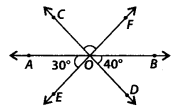
Solution: ∵ AB is a straight line.
∴ ∠AOE + ∠EOD + ∠DOB = 180°
⇒ ∠EOD = 180° -30° – 40° = 110° ——— (i)
[ ∵∠AOE = 30° and ∠DOB =40° (given)]
Now, CD and EF intersect each other at O.
∴ ∠COF = ∠EOD = 110° [Using (i)] [Vertically opposite angles]
Thus, ∠COF = 110°
Q.95. Measures (in degrees) of two complementary angles are two consecutive even integers. Find the angles.
Solution: Let one angle be 2x and the other angle be 2x + 2.
We know that the sum of the measures of the complementary angles is 90°
According to question,
2x + 2x + 2 = 90°
⇒ 4x = 90° – 2 = 88°
∴ 2x = 2 × 22° = 44° and 2x + 2 = 44° +2 = 46°
Thus, one angle is 44° and other is 46°
Q.96. If a transversal intersects two parallel lines, and the difference of two interior angles on the same side of a transversal is 20°, find the angles.
Solution: Let one angle be x and other be y.
Since, a transversal intersects two parallel lines, then interior angles on the same side of a transversal are supplementary.
∴ x + y = 180° ———– (i)
and x – y = 20° ——— (ii) [Given]
Adding (i) and (ii), we get
2x = 180° + 20° = 200°
Putting value of x in (i), we get
100° + y = 180 ⇒ y = 180° – 100° = 80°
Thus, one angle is 100° and other is 80°.
Q.97. Two angles are making a linear pair. If one of them is one-third of the other, find the angles.
Solution: Let one angle be x.
Since, two angles form a linear pair.
∴ Other angle is 180° – x.
According to question,
⇒ 3x = 180° – x ⇒ 3x + x = 180°
⇒ 4x = 180°
Thus, one angle is 45° and other is 180° – 45° = 135°
Q.98. Measures (in degrees) of two supplementary angles are consecutive odd integers. Find the angles.
Solution: Let one angle be 2x + 1, then the other angle is 2x + 3.
We know that the sum of the measures of the supplementary angles is 180°.
According to question,
2x + 1 + 2x + 3 = 180°
⇒ 4x + 4 = 180° ⇒ 4x = 180°- 4 = 176°
∴ 2x + 1 = 2 × 44° + 1 = 88° + 1 = 890
and 2x + 3 = 2 × 44° + 3 = 88° + 3 = 91°
Thus, one angle is 89° and other is 91°
Q.99. In the given figure, AE || GF || BD, AB||CG|| DF and ∠CHE = 120°. Find ∠ABC and ∠CDE.

Solution: Since, AE || BD and CH is a transversal.
∴∠CHE = ∠HCB – 120° ———- (i) [Alternate interior angles]
Now, CH || DF and CD is a transversal.
∴ ∠HCB =∠CDE [Corresponding angles]
⇒ ∠CDE-120° ——- (ii) [Using (1)]
Also, AB || DF and BD is a transversal.
∴ ∠ABC + ∠CDE = 180° [Co-interior angles]
⇒ ∠ABC = 180° – 120° [Using (ii)]
= 60°
Thus, ∠ABC = 60° and ∠CDE = 120°
Q.100. In the given figure, find the value of ∠BOC, if points A, O and B are collinear.
Solution: Given points A, O and B are collinear.
∴ AOB is a straight line.
⇒ (x – 10)° +(4x – 25)° + (x + 5)° = 180° [Angles on a straight line]
⇒ (6x – 30) = 180 ⇒ 6x – 180 + 30 = 210
Now, ∠BOC = (x + 5)° = (35 + 5) = 40°
Thus, ∠BOC = 40°
Q.101. In the given figure, if l || m, find the values of a and b.
Solution: Since, l || m and AB is a transversal.
∴ b + 132° = 180° [Co-interior angles]
⇒ b = 180° – 132° = 48°
∴ b = 48° ——— (i)
Now, l || m and AC is a transversal.
∴ (a + b) + 65° = 180° [Co-interior angles]
⇒ a = 180° – 65° = 48° [Using (i)]
⇒ a = 67°
Thus, a = 67° and b = 48°
Q.102. In the given figure, 4m and a line t intersects these lines at P and Q, respectively. Find the sum 2a +b.
Solution:
Since, l || m and is a transversal.
∴ a = 132 [Corresponding angles]
and b = 132° [Vertically opposite angles]
Now, 2a + b = 2 × 132° + 132°
= 264° + 132° = 396°
Q.103. In the given figure, QP || RS. Find the values of a and b.
Solution:
Since, QP || RS and QR is a transversal.
∴ b = 70° [Corresponding angles]
Now, QP || RS and PR is a transversal.
∴ a = 65° [Alternate interior angles]
Hence, a = 65° and b = 70°.
Q.104. In the given figure, PO || RT. Find the value of a + b.
Solution: Since, PQ || RT and PR is a transversal.
∴ a = 45° [Corresponding angles]
Now, PQ || RT and RQ is a transversal.
∴ b = 55° [Alternate interior angles]
Now, a + b = 45° + 55° = 100°
Q.105. In the given figure, PQ, RS and UT are parallel lines.
If c = 57∘ and  , find the value of d.
, find the value of d.
If c = 75 and , find b,
, find b,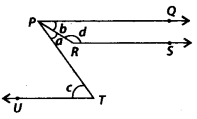
Solution: (i) Since, PQ || UT and PT is a transversal.
∴ a + b = c [Alternate interior angles]
⇒ b = c – a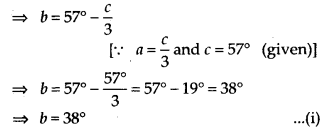
Now, PQ || RS and PR is a transversal.
∴ b + d = 180° [Co-interior angles]
⇒ d = 180°- 38° = 142° [Using (i)]
Thus, d = 142°
(ii) PQ || UT and PT is a transversal.
∴ a + b = c [Alternate interior angles]
Q.106. In the given figure, AB||CD. Find the reflex ∠EFG.
Solution: Since, AB || l and EF is a transversal.
∴ ∠1 = 34° [Alternate interior angles]
Now, l is also parallel to CD and FG is a transversal. .
∴ ∠2 + 135° = 180° [Co-interior angles]
⇒ ∠2 = 180° – 135° = 45°
Also, ∠EFG = ∠1 + ∠2 – 34° +45° = 79°
The reflex ∠EFG = 360° – 79° = 281°
Q.107. In the given figure, two parallel lines l and m are cut by two transversals n and p. Find the values of x and y.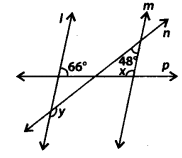
Solution: Since, l || m and p is a transversal.
∴ x + 66° = 180° [Co-interior angles]
⇒ x = 180° – 66° = 114°
Now, l || m and n is a transversal.
∴ y + 48° = 180° [Co-interior angles]
⇒ y = 180° – 48° = 132°
Thus, x = 114° and y = 132°
Q.108. In the given figure, l, m and n are parallel lines, and the lines p and q are also parallel. Find the values of a, b and c.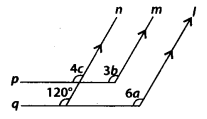
Solution: l || n and q is a transversal.
∴ 6a = 120° [Corresponding angles]
Now, p || q and n is a transversal.
∴ 4c = 120° [Corresponding angles]
Now, p || q and n is a transversal.
∴ 4c = 120° [Corresponding angles]
Also, m || n and p is transversal.
∴ 4c = 3b [Corresponding angles]
⇒ 4 × 30° = 3b [using (i)]
Thus, a = 20°, b = 40° and c = 30°
Q.109. In the given figure, state which pair of lines are parallel. Give reason.
Solution: We have,
∠1 = 120° [Vertically opposite angles]
Now, 60° + ∠1 = 60° + 120° = 180° and these angles are interior angles on the same side of transversal l.
Thus, m || n as the sum of co-interior angles is 180°
Q.110. In the given figure, examine whether the following pairs of lines are parallel or not:
(i) EF and GH
(ii) AB and CD
Solution: We have,
(i)∠1 = 65° [Vertically opposite angles]
As ∠RSP and ∠QPD are corresponding angles and are not equal.
∴ EF and GH are not parallel lines.
(ii) EF is a straight line.
∴ ∠RSC + ∠CSF = 180° [Linear pair]
⇒ ∠RSC = 180° – 65° = 115°
As angles ∠QRS and ∠CSR are alternate interior angles and are equal.
∴ AB || CD.
Q.111. In the given figure, find out which pair of lines are parallel:
Solution: We have,
∠FOR + ∠QRH = 123° + 57° = 180°
These angles are on the same side of transversal CD.
∴ EF || GH
Now, EF || GH and AB is a transversal.
∴ ∠TUR = ∠UVQ = 122° [Corresponding angles]
As ∠UVQ and ∠ROF are corresponding angles and are not equal.
∴ AB and CD are not parallel lines.
Q.112. In the given figure, show that
(i) AB || CD
(ii) EF || GH
Solution: We have,
(i) ∠PSC = ∠RSF = 50° [Vertically opposite angles]
∠APS + ∠PSC = 130° + 50° = 180°
As ∠APS and ∠PSC are interior angles on the same side of transversal EF and are supplementary.
∴ AB || CD
(ii) ∠APS = ∠EPQ = 130° [Vertically opposite angles]
∠EPQ+ ∠GQP = 130° + 50° = 180°
As ∠EPQ and ∠GQP are interior angles on the same side of transversal AB and are supplementary
∴ EF || GH
Q.113. In the given figure, two parallel lines l and m are cut by two transversals p and 4. Determine the values of x and y.
Solution: Since, l || m and q is a transversal.
∴ x = 110° [Alternate interior angles]
Now, l || m and p is a transversal.
∴ y + 80° = 180° [Co-interior angles]
∴ y = 180° – 80° = 100°
Thus, x = 110° and y = 100°
|
76 videos|452 docs|39 tests
|
FAQs on NCERT Exemplar Solutions: Lines & Angles - Mathematics (Maths) Class 7 (Old NCERT)
| 1. What are the different types of lines based on their position in relation to each other? |  |
| 2. How do you determine if two lines are parallel? |  |
| 3. What is the sum of angles formed on a straight line? |  |
| 4. How can you prove that two lines are perpendicular to each other? |  |
| 5. Can two lines be both parallel and perpendicular to each other? |  |

















